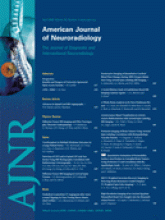Research ArticleNeurointervention
Outcomes of Ruptured Intracranial Aneurysms Treated by Microsurgical Clipping and Endovascular Coiling in a High-Volume Center
S.K. Natarajan, L.N. Sekhar, B. Ghodke, G.W. Britz, D. Bhagawati and N. Temkin
American Journal of Neuroradiology April 2008, 29 (4) 753-759; DOI: https://doi.org/10.3174/ajnr.A0895
S.K. Natarajan
L.N. Sekhar
B. Ghodke
G.W. Britz
D. Bhagawati

References
- ↵Hop JW, Rinkel GJ, Algra A, et al. Case-fatality rates and functional outcome after subarachnoid hemorrhage: a systematic review. Stroke 1997;28:660–64
- ↵Schievink WI, Wijdicks EF, Parisi JE, et al. Sudden death from aneurysmal subarachnoid hemorrhage. Neurology 1995;45:871–74
- ↵Molyneux A, Kerr R, Stratton I, et al. International Subarachnoid Aneurysm Trial (ISAT) of neurosurgical clipping versus endovascular coiling in 2143 patients with ruptured intracranial aneurysms: a randomised trial. Lancet 2002;360:1267–74
- ↵Molyneux AJ, Kerr RS, Yu LM, et al. International subarachnoid aneurysm trial (ISAT) of neurosurgical clipping versus endovascular coiling in 2143 patients with ruptured intracranial aneurysms: a randomised comparison of effects on survival, dependency, seizures, rebleeding, subgroups, and aneurysm occlusion. Lancet 2005;366:809–17
- ↵Koivisto T, Vanninen R, Hurskainen H, et al. Outcomes of early endovascular versus surgical treatment of ruptured cerebral aneurysms. A prospective randomized study. Stroke 2000;31:2369–77
- ↵Rabinstein AA, Pichelmann MA, Friedman JA, et al. Symptomatic vasospasm and outcomes following aneurysmal subarachnoid hemorrhage: a comparison between surgical repair and endovascular coil occlusion. J Neurosurg 2003;98:319–25
- ↵Dehdashti AR, Mermillod B, Rufenacht DA, et al. Does treatment modality of intracranial ruptured aneurysms influence the incidence of cerebral vasospasm and clinical outcome? Cerebrovasc Dis 2004;17:53–60. Epub 2003 Oct 3.
- ↵Frazer D, Ahuja A, Watkins L, et al. Coiling versus clipping for the treatment of aneurysmal subarachnoid hemorrhage: a longitudinal investigation into cognitive outcome. Neurosurgery 2007;60:434–41; discussion 441–42
- ↵Hoh BL, Topcuoglu MA, Singhal AB, et al. Effect of clipping, craniotomy, or intravascular coiling on cerebral vasospasm and patient outcome after aneurysmal subarachnoid hemorrhage. Neurosurgery 2004;55:779–86; discussion 786–89
- ↵Longstreth WT Jr, Nelson LM, Koepsell TD, et al. Clinical course of spontaneous subarachnoid hemorrhage: a population-based study in King County, Washington. Neurology 1993;43:712–18
- Adams HP Jr, Kassell NF, Torner JC, et al. Early management of aneurysmal subarachnoid hemorrhage. A report of the Cooperative Aneurysm Study. J Neurosurg 1981;54:141–45
- Hijdra A, van Gijn J, Nagelkerke NJ, et al. Prediction of delayed cerebral ischemia, rebleeding, and outcome after aneurysmal subarachnoid hemorrhage. Stroke 1988;19:1250–56
- ↵Le Roux PD, Elliott JP, Newell DW, et al. Predicting outcome in poor-grade patients with subarachnoid hemorrhage: a retrospective review of 159 aggressively managed cases. J Neurosurg 1996;85:39–49
- ↵Fraser JF, Riina H, Mitra N, et al. Treatment of ruptured intracranial aneurysms: looking to the past to register the future. Neurosurgery 2006;59:1157–66; discussion 1166–67
- ↵
- Murayama Y, Malisch T, Guglielmi G, et al. Incidence of cerebral vasospasm after endovascular treatment of acutely ruptured aneurysms: report on 69 cases. J Neurosurg 1997;87:830–35
- ↵Yalamanchili K, Rosenwasser RH, Thomas JE, et al. Frequency of cerebral vasospasm in patients treated with endovascular occlusion of intracranial aneurysms. AJNR Am J Neuroradiol 1998;19:553–58
- ↵Gruber A, Ungersbock K, Reinprecht A, et al. Evaluation of cerebral vasospasm after early surgical and endovascular treatment of ruptured intracranial aneurysms. Neurosurgery 1998;42:258–67; discussion 267–68
- ↵Barrow DL. Bad science ISAT: the impact on neurosurgical practice. Clin Neurosurg 2004;51:126–31
- ↵
In this issue
Advertisement
S.K. Natarajan, L.N. Sekhar, B. Ghodke, G.W. Britz, D. Bhagawati, N. Temkin
Outcomes of Ruptured Intracranial Aneurysms Treated by Microsurgical Clipping and Endovascular Coiling in a High-Volume Center
American Journal of Neuroradiology Apr 2008, 29 (4) 753-759; DOI: 10.3174/ajnr.A0895
0 Responses
Jump to section
Related Articles
- No related articles found.
Cited By...
- Clinical outcome after surgical clipping or endovascular coiling for cerebral aneurysms: a pragmatic meta-analysis of randomized and non-randomized trials with short- and long-term follow-up
- Endovascular Management of Distal ACA Aneurysms: Single-Institution Clinical Experience in 22 Consecutive Patients and Literature Review
- Clipping Versus Coiling for Ruptured Intracranial Aneurysms: A Systematic Review and Meta-Analysis
- Clinical predictors of delayed cerebral ischemia after subarachnoid hemorrhage: first experience with coil embolization in the management of ruptured cerebral aneurysms
- Endovascular Treatment or Neurosurgical Clipping of Ruptured Intracranial Aneurysms: Effect on Angiographic Vasospasm, Delayed Ischemic Neurological Deficit, Cerebral Infarction, and Clinical Outcome
- Does treatment modality affect vasospasm distribution in aneurysmal subarachnoid hemorrhage: differential use of intra-arterial interventions for cerebral vasospasm in surgical clipping and endovascular coiling populations
- Coiling of Intracranial Aneurysms: A Systematic Review on Initial Occlusion and Reopening and Retreatment Rates
This article has not yet been cited by articles in journals that are participating in Crossref Cited-by Linking.
More in this TOC Section
Similar Articles
Advertisement











